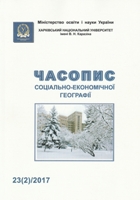Impact of the of geographical space's length on the distribution of international tourist flows
Abstract
The article suggests and verifies the assumption that such a property of geographical space as the length affects the distribution of international tourist flows due to the distance between the countries of origin and destination of tourists, as well as the length of the common border by land, which in many cases determines the volume of tourist exchange between the countries-neighbors. As a result of the analysis of the structure of international tourism by countries, the nature of the influence of the length of geographical space on the geography of the distribution of international tourist flows has been determined. In particular, a pattern has been found in which the share of arrivals or departures in the structure of international tourism of a certain country can be any, but usually does not exceed the value that decreases from distance by the exponent. So, it is defined that distance does not determine, but limits the intensity of tourist exchange between countries. It is also estimated that around 50% of international tourist exchange is between neighboring countries, and the share of a neighboring country in the structure of tourist arrivals or departures is often consistent with the length of the common border by land.
In addition, the cases that not comply with this pattern are explained. Exceptions are usually related to countries with an “overseas” geographical location, including are in the part of the world where they are surrounded by mentally different countries. At the same time, each of them near or far has a mentally close large country, from where arrive a much more tourists than usual for such a distance. Exceptions for international tourist flows in the neighborhood are usually associated with the distortion of the isotropy of the geographical space, primarily in the border areas, in particular due to the uneven distribution of the population in the countries of origin or tourist potential in the destinations.
Downloads
References
2. Erina, A.M. (2001). Statystychne modelyuvannya ta prognozuvannya [Statistical modeling and forecasting]. Kyiv: KNEU, 170.
3. Korol, O.D., Skutar T.D. (2008). Mizhnarodnyi turyzm: metodyka i materialy statystychnykh doslidzhen [Interna-tional tourism: methods and materials of statistical research]. Chernivtsi: Ruta, 64.
4. Lyubitseva, O.O. (2003). Rynok turystychnykh posluh [The market of tourist services]. Kyiv: Alterpres, 436 p.
5. Hagerstrand, T. (1970). What about people in regional science? Lund: Springer – Verlag.
6. International tourism: UNWTO Tourism Highlights, 2001-2016 Editions. Available at: http://mkt.unwto.org/publications
7. OECD Tourism Trends and Policies 2010: OECD Publishing (2010). Available at: https://books.google.com.ua/books?id=UC7WAgAAQBAJ
8. Tourism flows outbound (by countries): Euromonitor International (2012). Available at: http://www.euromonitor.com/travel
Copyright (c) 2017 Олександр Король

This work is licensed under a Creative Commons Attribution 4.0 International License.




